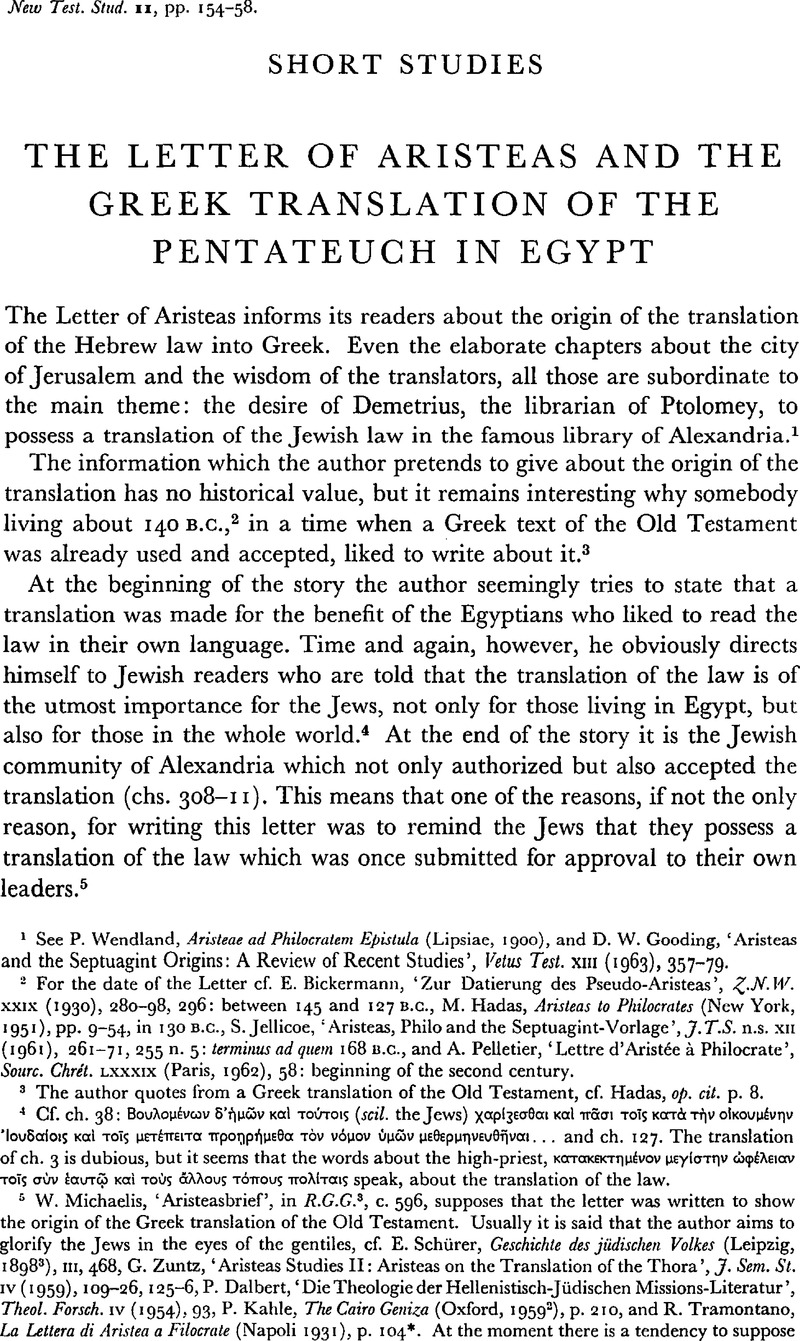Article contents
The Letter of Aristeas and the Greek Translation of the Pentateuch in Egypt
Published online by Cambridge University Press: 05 February 2009
Abstract

- Type
- Short Studies
- Information
- Copyright
- Copyright © Cambridge University Press 1965
References
page 154 note 1 See Wendland, P., Aristeae ad Philocratem Epistula (Lipsiae, 1900)Google Scholar, and Gooding, D. W., ‘Aristeas and the Septuagint Origins: A Review of Recent Studies’, Vetus Test, xxiii (1963), 357–79.CrossRefGoogle Scholar
page 154 note 2 For the date of the Letter cf. Bickermann, E., ‘Zur Datierung des Pseudo-Aristeas’, Z.N.W. xxix (1930), 280–98, 296Google Scholar: between 145 and 127 b.c., Hadas, M., Aristeas to Philocrales (New York, 1951), pp. 9–54Google Scholar, in 130 b.c., Jellicoe, S., ‘Aristeas, Philoand the Septuagint-Vorlage’, J.T.S. n.s. xii (1961), 261–71, 255 n. 5Google Scholar: terminus ad quern 168 b.c., and Pelletier, A., ‘Lettre d'Aristée à Philocrate’, Sourc. Chrét. lxxxix (Paris, 1962), 58Google Scholar: beginning of the second century.
page 154 note 3 The author quotes from a Greek translation of the Old Testament, cf. Hadas, op. cit. p. 8.
page 154 note 4 Cf. ch. 38: Bουλομ⋯νων δ'⋯μ⋯ν κα⋯ το⋯τοισ (scil, the Jews) ![]() …and ch. 127. The translation of ch. 3 is dubious, but it seems that the words about the high-priest,
…and ch. 127. The translation of ch. 3 is dubious, but it seems that the words about the high-priest, ![]() speak, about the translation of the law.
speak, about the translation of the law.
page 154 note 5 Michaelis, W., ‘Aristeasbrief’, in R.G.G. 3, c. 596Google Scholar, supposes that the letter was written to show the origin of the Greek translation of the Old Testament. Usually it is said that the author aims to glorify the Jews in the eyes of the gentiles, cf. Schürer, E., Geschichte des jüdiscken Volkes (Leipzig, 1898 3), iii, 468Google Scholar, Zuntz, G., ‘Aristeas Studies II: Aristeas on the Translation of the Thora’, J. Sem. St. iv (1959), 109–26, 125–6Google Scholar, Dalbert, P., ‘Die Theologie der Hellenistisch-Jüdischen Missions-Literatur’, Theol. Forsch. iv (1954), 93Google Scholar, Kahle, P., The Cairo Geniza (Oxford, 1959 2), p. 210Google Scholar, and Tramontano, R., La Lettera di Aristea a Filocrate (Napoli 1931), p. 104*.Google Scholar At the moment there is a tendency to suppose the letter to be written by a Jew for the Jews: M. Hadas, op. cit., Orlinsky, H. M., ‘Review M. Hadas’, Crozer Quart, xxrx (1952), 201–5, 201–2Google Scholar, Tscherikover, V., ‘The Ideology of the Letter of Aristeas’, Harv. Theol. Rev. li (1958), 59–85CrossRefGoogle Scholar, Jellicoe, art. cit., but also already in Frankel, Z., Vorstudien zu der Septuaginla (Leipzig, 1841), pp. 43–44.Google Scholar
page 155 note 1 Chs. 32 and 39.
page 155 note 2 Chs. 32, 39 and 302.
page 155 note 3 Ch. 307.
page 155 note 4 Ch. 308.
page 155 note 5 Cf. the Prologue of Sirach, Jos., Ant. xii, 2, 11–119, Ant. 1, 10–12, c. App. ii, 44–7, Philo, de vita Mosis 11, 5–7, Meg. 1, 8 (R. Sim. b. Gamaliel † 70), b. Meg. 9a, p. Meg. 1, 71d. Later rejected by Sopherim 8 (ed. H. Bardtke), ‘Der Traktat der Schreiber (Sopherim)’, Wissensch. Zeit. Karl-Marx-Universität Leipzig, iii (1953/4), 31–49, 33.
page 155 note 6 ![]()
page 156 note 1 Kahle, P., The Cairo…, p. 213.Google Scholar Also Pelletier, J., Flavins Josèphe adapteur de la Lettre d'Aristée (Paris, 1962), p. 80Google Scholar, speaks about ‘versions antérieures’. The same opinion in Jellicoe, art. cit. p. 267.
page 156 note 2 See Zuntz, art cit., pp. 117–18 and Pelletier, Lettre…, p. 119 n. 3: ‘Je pense done que σεσ⋯μανται désigne ici l'action d'écrire, mais sous l'aspect très technique de calligraphic d'edition.’
page 157 note 1 Meg. 2, 1 and 2 (ed. Danby, p. 203).
page 157 note 2 See for Assyrian script: IV Ezr. xiv. 42, b. Shabb. 115, b. Sanh. 21b, b. Shabb. 103b and Fischer, J., ‘Das Alphabet der LXX-Vorlage im Pentateuch’, Alttestamentl. Abhandl. x, 2 (Münster, 1924), iii–xii.Google Scholar
page 157 note 3 In the temple of Jerusalem the standard text was available according to which all manuscripts had to be corrected, see Blau, L., Sludien zum althebräischen Buchwesen, I (Strassbourg, 1902), pp. 99–114.Google Scholar
page 157 note 4 Cf. van Unnik, W. C., ‘De la Règie ![]() dans l'Histoire du Canon’, Vig. Christ. iii (1949), 1–36.CrossRefGoogle Scholar
dans l'Histoire du Canon’, Vig. Christ. iii (1949), 1–36.CrossRefGoogle Scholar
page 157 note 5 According to Fischer, op. cit. p. 115, the alphabet of the Septuagint-Vorlage had been written in a form approaching the Assyrian script.
page 158 note 1 For the translation ‘carelessly inserted’ see Jellicoe, art. cit. p. 268, and Pelletier, La Lettre…, p. 335; ‘carelessly translated’, in H. T. Andrews in Charles, R. H., The Apocrypha and Pseudepigrapha of the Old Testament (Oxford, 1913), ii, 121Google Scholar, and Kahle, The Cairo…, p. 213.
page 158 note 2 The word ‘inspiration’ is not used in this work.
- 1
- Cited by




